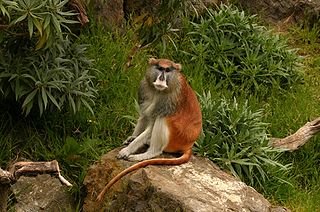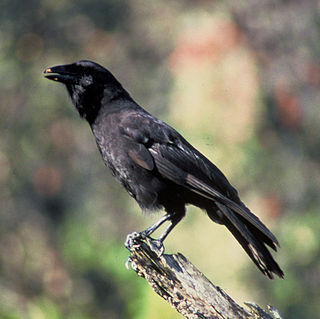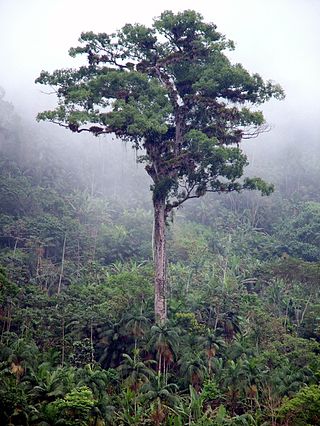
The International Union for Conservation of Nature (IUCN) Red List of Threatened Species, also known as the IUCN Red List or Red Data Book, founded in 1964, is an inventory of the global conservation status and extinction risk of biological species. A series of Regional Red Lists, which assess the risk of extinction to species within a political management unit, are also produced by countries and organizations.

The macaques constitute a genus (Macaca) of gregarious Old World monkeys of the subfamily Cercopithecinae. The 23 species of macaques inhabit ranges throughout Asia, North Africa, and Europe. Macaques are principally frugivorous, although their diet also includes seeds, leaves, flowers, and tree bark. Some species such as the long-tailed macaque will supplement their diets with small amounts of meat from shellfish, insects, and small mammals. On average, a southern pig-tailed macaque in Malaysia eats about 70 large rats each year. All macaque social groups are arranged around dominant matriarchs.

Erythrocebus is a genus of Old World monkey. All three species in this genus are found in Africa, and are known as patas monkeys. While previously considered a monotypic genus containing just E. patas, a 2017 review argued that, based on morphological evidence and heavy geographic separation between taxa, E. patas should be split back into distinct species as recognised in the 19th century.

Presbytis is a genus of Old World monkeys also known as langurs, leaf monkeys, or surilis. Members of the genus live in the Thai-Malay Peninsula, on Sumatra, Borneo, Java and smaller nearby islands.

Couratari is a genus of trees in the family Lecythidaceae, first described as a genus in 1775. They are native to tropical South America and Central America.

An IUCN Red List Critically Endangered species is one that has been categorized by the International Union for Conservation of Nature as facing an extremely high risk of extinction in the wild. As of December 2023, of the 157,190 species currently on the IUCN Red List, 9,760 of those are listed as Critically Endangered, with 1,302 being possibly extinct and 67 possibly extinct in the wild.

A species that is extinct in the wild (EW) is one that has been categorized by the International Union for Conservation of Nature as only consisting of living members kept in captivity or as a naturalized population outside its historic range. Classification requires exhaustive surveys conducted within the species' known habitat with consideration given to seasonality, time of day, and life cycle. Once a species is classified as EW, the only way for it to be downgraded is through reintroduction.

Cariniana is a genus of trees in the family Lecythidaceae, first described as a genus in 1842. The entire genus is native to South America. Many are of importance for timber production. Species of this genus may be known commonly as jequitibá.
Couratari asterophora is a species of woody plant in the family Lecythidaceae. It is found only in Brazil. It is threatened by habitat loss.
Couratari asterotricha, also known as imbirema, is a species of plant in the family Lecythidaceae. It is a critically endangered species endemic to Brazil.
Couratari atrovinosa is a species of flowering plant in the family Lecythidaceae. It is endemic to Brazil, where it is known only from Amazonas.
Couratari calycina is a species of woody plant in the family Lecythidaceae. It is found only in Guyana.

Couratari guianensis, the fine-leaf wadara, cachimbo caspi, cachimbo, capa de tabaco, coco cabuyo, or tauari, is a species of woody plant in the family Lecythidaceae. It is found in Brazil, Colombia, Costa Rica, French Guiana, Guyana, Panama, Peru, Suriname, and Venezuela. It is threatened by habitat loss.
Couratari longipedicellata is a species of rainforest tree in the Monkeypot Family (Lecythidaceae). It is found only in Brazil. It is threatened by habitat loss. Perhaps its most remarkable feature is its very large seeds; up to 9.5 cm long by up to 2.3 cm wide.
Couratari prancei is a species of woody plant in the family Lecythidaceae. It is found in Brazil and Peru. It is threatened by habitat loss.
Couratari pyramidata is a species of flowering plant in the family Lecythidaceae. It is endemic to Brazil, where it is limited to the region around Rio de Janeiro.
Couratari tauari is a species of woody plant in the family Lecythidaceae. It is found only in Brazil. It is threatened by habitat loss.
Utricularia sandwithii is a small, probably perennial, carnivorous plant that belongs to the genus Utricularia. U. sandwithii is endemic to Brazil, Guyana, Suriname, and Venezuela. It grows as a terrestrial plant in damp, sandy soils in savannas at altitudes from near sea level to 600 m (1,969 ft). U. sandwithii was originally described and published by Peter Taylor in 1967 for the Botany of the Guyana Highland series, though it was probably collected as early as 1851 by Heinrich Wullschlägel in Suriname. It had also been collected by George Samuel Jenman in 1881 in Guyana, but was overlooked until Taylor presented his work in 1967.

The serow, is any of four species of medium-sized goat-like or antelope-like mammals in the genus Capricornis. All four species of serow were, until recently, classified under Naemorhedus, which now only contains the gorals.

Allochrocebus is a primate genus including the terrestrial guenons: the L'Hoest's monkey, the Preuss's monkey, and the sun-tailed monkey.











